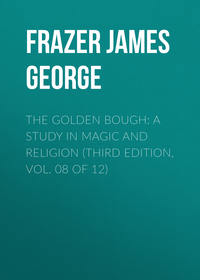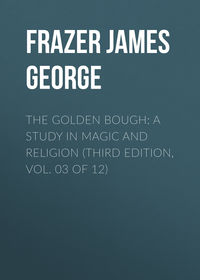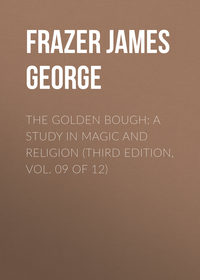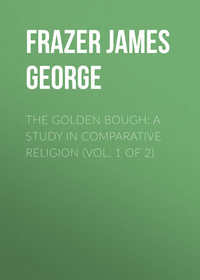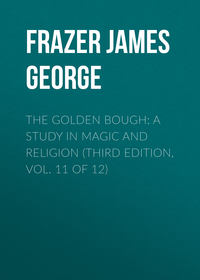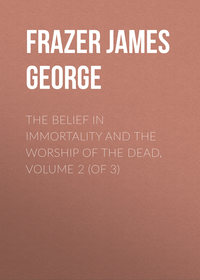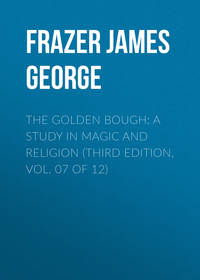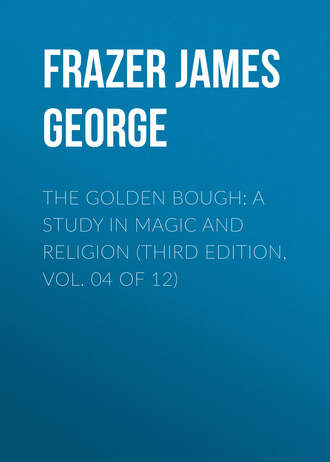 полная версия
полная версияThe Golden Bough: A Study in Magic and Religion (Third Edition, Vol. 04 of 12)
Substitution of the laurel for the oak.
But why should the crown of oak have ceased to be the badge of victory? and why should a wreath of laurel have taken its place? The abandonment of the oak crown may have been a consequence of the disappearance of the oak itself from the neighbourhood of Delphi; in Greece, as in Italy, the deciduous trees have for centuries been retreating up the mountain sides before the advance of the evergreens.219 When the last venerable oak, the rustling of whose leaves in the breeze had long been listened to as oracular, finally succumbed through age, or was laid low by a storm, the priests may have cast about for a tree of another sort to take its place. Yet they sought it neither in the lower woods of the valley nor in the dark forests which clothe the upper slopes of Parnassus above the frowning cliffs of Delphi. Legend ran that after the slaughter of the dragon, Apollo had purged himself from the stain of blood in the romantic Vale of Tempe, where the Peneus flows smoothly in a narrow defile between the lofty wooded steeps of Olympus and Ossa. Here the god crowned himself with a laurel wreath, and thither accordingly at the Festival of Crowning his human representative went to pluck the laurel for his brows.220 The custom, though doubtless ancient, can hardly have been original. We must suppose that in the beginning the dragon-guarded tree, whether an oak or a laurel, grew at Delphi itself. But why should the laurel be chosen as a substitute for the oak? Mr. A. B. Cook has suggested a plausible answer. The laurel leaf resembles so closely the leaf of the ilex or holm-oak in both shape and colour that an untrained observer may easily confuse the two. The upper surface of both is a dark glossy green, the lower surface shews a lighter tint. Nothing, therefore, could be more natural than to make the new wreath out of leaves which looked so like the old oak leaves that the substitution might almost pass undetected.221
Whether at Thebes, as at Delphi, the laurel had ousted the oak from the place of honour at the festival of the Slaying of the Dragon, we cannot say. The oak has long disappeared from the low hills and flat ground in the neighbourhood of Thebes, but as late as the second century of our era there was a forest of ancient oaks not many miles off at the foot of Mount Cithaeron.222
Hypothesis of octennial kings at Delphi and Thebes, who personated dragons or serpents. Animals sacred to royal families. Greek stories of the transformation of gods into beasts point to a custom of a sacred marriage in which the actors masqueraded as animals.
It has been conjectured that in ancient days the persons who wore the wreath of laurel or oak at the octennial festivals of Delphi and Thebes were no other than the priestly kings, who personated the god, slew their predecessors in the guise of dragons, and reigned for a time in their stead.223 The theory certainly cannot be demonstrated, but there is a good deal of analogy in its favour. An eight years' tenure of the kingship at Delphi and Thebes would accord with the similar tenure of the office at Sparta and Cnossus. And if the kings of Cnossus disguised themselves as bulls, there seems no reason why the kings of Delphi and Thebes should not have personated dragons or serpents. In all these cases the animal whose guise the king assumed would be sacred to the royal family. At first the relation of the beast to the man would be direct and simple; the creature would be revered for some such reason as that for which a savage respects a certain species of animals, for example, because he believes that his ancestors were beasts of the same sort, or that the souls of his dead are lodged in them. In later times the sanctity of the species would be explained by saying that a god had at some time, and for some reason or other, assumed the form of the animal. It is probably not without significance that in Greek mythology the gods in general, and Zeus in particular, are commonly said to have submitted to this change of shape for the purpose of prosecuting a love adventure. Such stories may well reflect a custom of a Sacred Marriage at which the actors played the parts of the worshipful animals. With the growth of culture these local worships, the relics of a barbarous age, would be explained away by tales of the loves of the gods, and, gradually falling out of practice, would survive only as myths.
Analogy of the Wolf Society of Arcadia to the Leopard Society of west Africa.
It is said that at the festival of the Wolf-god Zeus, held every nine years on the Wolf-mountain in Arcadia, a man tasted of the bowel of a human victim mixed with the bowels of animals, and having tasted it he was turned into a wolf, and remained a wolf for nine years, when he changed back again into a man if in the interval he had abstained from eating human flesh.224 The tradition points to the existence of a society of cannibal wolf-worshippers, one or more of whom personated, and were supposed to embody, the sacred animal for periods of nine years together. Their theory and practice would seem to have agreed with those of the Human Leopard Societies of western Africa, whose members disguise themselves in the skins of leopards with sharp claws of steel. In that guise they attack and kill men in order to eat their flesh or to extract powerful charms from their bodies.225 Their mode of gaining recruits is like that of the Greek Wolf Society. When a visitor came to a village inhabited by a Leopard Society, “he was invited to partake of food, in which was mixed a small quantity of human flesh. The guest all unsuspectingly partook of the repast, and was afterwards told that human flesh formed one of the ingredients of the meal, and that it was then necessary that he should join the society, which was invariably done.”226 As the ancient Greeks thought that a man might be turned into a wolf, so these negroes believe that he can be changed into a leopard; and, like the Greeks, some of them fancy that if the transformed man abstains during his transformation from preying on his fellows he can regain his human shape, but that if he once laps human blood he must remain a leopard for ever.227
Legend of the transformation of Cadmus and Harmonia into serpents. Transmigration of the souls of the dead into serpents. Kings claim kinship with the most powerful animals.
The hypothesis that the ancient kings of Thebes and Delphi had for their sacred animal the serpent or dragon, and claimed kinship with the creature, derives some countenance from the tradition that at the end of their lives Cadmus and his wife Harmonia quitted Thebes and went to reign over a tribe of Encheleans or Eel-men in Illyria, where they were both finally transformed into dragons or serpents.228 To the primitive mind an eel is a water-serpent;229 it can hardly, therefore, be an accident that the serpent-killer afterwards reigned over a tribe of eel-men and himself became a serpent at last. Moreover, according to one account, his wife Harmonia was a daughter of the very dragon which he slew.230 The tradition would fit in well with the hypothesis that the dragon or serpent was the sacred animal of the old royal house of Thebes, and that the kingdom fell to him who slew his predecessor and married his daughter. We have seen reason to think that such a mode of succession to the throne was common in antiquity.231 The story of the final transformation of Cadmus and Harmonia into snakes may be a relic of a belief that the souls of the dead kings and queens of Thebes transmigrated into the bodies of serpents, just as Caffre kings turn at death into boa-constrictors or deadly black snakes.232 Indeed the notion that the souls of the dead lodge in serpents is widely spread in Africa and Madagascar.233 Other African tribes believe that their dead kings and chiefs turn into lions, leopards, hyaenas, pythons, hippopotamuses, or other creatures, and the animals are respected and spared accordingly.234 In like manner the Semang and other wild tribes of the Malay Peninsula imagine that the souls of their chiefs, priests, and magicians transmigrate at death into the bodies of certain wild beasts, such as elephants, tigers, and rhinoceroses, and that in their bestial form the dead men extend a benign protection to their living human kinsfolk.235 Even during their lifetime kings in rude society sometimes claim kinship with the most formidable beasts of the country. Thus the royal family of Dahomey specially worships the leopard; some of the king's wives are distinguished by the title of Leopard Wives, and on state occasions they wear striped cloths to resemble the animal.236 One king of Dahomey, on whom the French made war, bore the name of Shark; hence in art he was represented sometimes with a shark's body and a human head, sometimes with a human body and the head of a shark.237 The Trocadero Museum at Paris contains the wooden images of three kings of Dahomey who reigned during the nineteenth century, and who are all represented partly in human and partly in animal form. One of them, Guezo, bore the surname of the Cock, and his image represents him as a man covered with feathers. His son Guelelé, who succeeded him on the throne, was surnamed the Lion, and his effigy is that of a lion rampant with tail raised and hair on his body, but with human feet and hands. Guelelé was succeeded on the throne by his son Behanzin, who was surnamed the Shark, and his effigy portrays him standing upright with the head and body of a fish, the fins and scales being carefully represented, while his arms and legs are those of a man.238 Again, a king of Benin was called Panther, and a bronze statue of him, now in the Anthropological Museum at Berlin, represents him with a panther's whiskers.239 Such portraits furnish an exact parallel to what I conceive to be the true story of the Minotaur. On the Gold Coast of Africa a powerful ruler is commonly addressed as “O Elephant!” or “O Lion!” and one of the titles of the king of Ashantee, mentioned at great ceremonies, is borri, the name of a venomous snake.240 It has been argued that King David belonged to a serpent family, and that the brazen serpent, which down to the time of Hezekiah was worshipped with fumes of burning incense,241 represented the old sacred animal of his house.242 In Europe the bull, the serpent, and the wolf would naturally be on the list of royal beasts.
The serpent the royal animal at Athens and Salamis.
If the king's soul was believed to pass at death into the sacred animal, a custom might arise of keeping live creatures of the species in captivity and revering them as the souls of dead rulers. This would explain the Athenian practice of keeping a sacred serpent on the Acropolis and feeding it with honey cakes; for the serpent was identified with Erichthonius or Erechtheus, one of the ancient kings of Athens, of whose palace some vestiges have been discovered in recent times. The creature was supposed to guard the citadel. During the Persian invasion a report that the serpent had left its honey-cake untasted was one of the strongest reasons which induced the people to abandon Athens to the enemy; they thought that the holy reptile had forsaken the city.243 Again, Cecrops, the first king of Athens, is said to have been half-serpent and half-man;244 in art he is represented as a man from the waist upwards, while the lower part of his body consists of the coils of a serpent.245 It has been suggested that like Erechtheus he was identical with the serpent on the Acropolis.246 Once more, we are told that Cychreus gained the kingdom of Salamis by slaying a snake which ravaged the island,247 but that after his death he, like Cadmus, appeared in the form of the reptile.248 Some said that he was a man who received the name of Snake on account of his cruelty.249 Such tales may preserve reminiscences of kings who assumed the style of serpents in their lifetime and were believed to transmigrate into serpents after death. Like the dragons of Thebes and Delphi, the Athenian serpent appears to have been conceived as a creature of the waters; for the serpent-man Erechtheus was identified with the water-god Poseidon,250 and in his temple, the Erechtheum, where the serpent lived, there was a tank which went by the name of “the sea of Erechtheus.”251
The wedding of Cadmus and Harmonia at Thebes may have been a dramatic representation of the marriage of the sun and moon at the end of the eight years' cycle.
If the explanation of the eight years' cycle which I have adopted holds good for Thebes and Delphi, the octennial festivals held at these places probably had some reference to the sun and moon, and may have comprised a sacred marriage of these luminaries. The solar character of Apollo, whether original or adventitious, lends some countenance to this view, but at both Delphi and Thebes the god was apparently an intruder who usurped the place of an older god or hero at the festival. At Thebes that older hero was Cadmus. Now Cadmus was a brother of Europa, who appears to have been a personification of the moon conceived in the form of a cow.252 He travelled westward seeking his lost sister till he came to Delphi, where the oracle bade him give up the search and follow a cow which had the white mark of the full moon on its flank; wherever the cow fell down exhausted, there he was to take up his abode and found a city. Following the cow and the directions of the oracle he built Thebes.253 Have we not here in another form the myth of the moon pursued and at last overtaken by the sun? and the famous wedding of Cadmus and Harmonia, to attend which all the gods came down from heaven,254 may it not have been at once the mythical marriage of the great luminaries and the ritual marriage of the king and queen of Thebes masquerading, like the king and queen of Cnossus, in the character of the lights of heaven at the octennial festival which celebrated and symbolised the conjunction of the sun and moon after their long separation, their harmony after eight years of discord? A better name for the bride at such a wedding could hardly have been chosen than Harmonia.
This theory confirmed by the astronomical symbols carried by the Laurel-bearer at the octennial festival of Laurel-bearing. The Olympic festival seems to have been based on the octennial cycle. Mythical marriage of the sun and moon at Olympia.
This theory is supported by a remarkable feature of the festival. At the head of the procession, immediately in front of the Laurel-bearer, walked a youth who carried in his hands a staff of olive-wood draped with laurels and flowers. To the top of the staff was fastened a bronze globe, with smaller globes hung from it; to the middle of the staff were attached a globe of medium size and three hundred and sixty-five purple ribbands, while the lower part of the staff was swathed in a saffron pall. The largest globe, we are told, signified the sun, the smaller the moon, and the smallest the stars, and the purple ribbands stood for the course of the year, being equal in number to the days comprised in it.255 The choir of virgins who followed the Laurel-bearer singing hymns256 may have represented the Muses, who are said to have sung and played at the marriage of Cadmus and Harmonia; down to late times the very spot in the market-place was shewn where they had discoursed their heavenly music.257 We may conjecture that the procession of the Laurel-bearing was preceded by a dramatic performance of the Slaying of the Dragon, and that it was followed by a pageant representative of the nuptials of Cadmus and Harmonia in the presence of the gods. On this hypothesis Harmonia, the wife of Cadmus, is only another form of his sister Europa, both of them being personifications of the moon. Accordingly in the Samothracian mysteries, in which the marriage of Cadmus and Harmonia appears to have been celebrated, it was Harmonia and not Europa whose wanderings were dramatically represented.258 The gods who quitted Olympus to grace the wedding by their presence were probably represented in the rites, whether celebrated at Thebes or in Samothrace, by men and women attired as deities. In like manner at the marriage of a Pharaoh the courtiers masqueraded in the likeness of the animal-headed Egyptian gods.259
Within historical times the great Olympic festival was always held at intervals of four, not of eight, years. Yet it too would seem to have been based on the octennial cycle. For it always fell on a full moon, at intervals of fifty and of forty-nine lunar months alternately.260 Thus the total number of lunar months comprised in two successive Olympiads was ninety-nine, which is precisely the number of lunar months in the octennial cycle.261 It is possible that, as K. O. Müller conjectured,262 the Olympic games may, like the Pythian, have originally been celebrated at intervals of eight instead of four years. If that was so, analogy would lead us to infer that the festival was associated with a mythical marriage of the sun and moon. A reminiscence of such a marriage appears to survive in the legend that Endymion, the son of the first king of Elis, had fifty daughters by the Moon, and that he set his sons to run a race for the kingdom at Olympia.263 For, as scholars have already perceived, Endymion is the sunken sun overtaken by the moon below the horizon, and his fifty daughters by her are the fifty lunar months of an Olympiad or, more strictly speaking, of every alternate Olympiad.264 If the Olympic festival always fell, as many authorities have maintained, at the first full moon after the summer solstice,265 the time would be eminently appropriate for a marriage of the luminaries, since both of them might then be conceived to be at the prime of their vigour.
The Olympic victors, male and female, may originally have represented Zeus and Hera or the Sun and Moon, and have reigned as divine king and queen for four or eight years.
It has been ingeniously argued by Mr. A. B. Cook266 that the Olympic victors in the chariot-race were the lineal successors of the old rulers, the living embodiments of Zeus, whose claims to the kingdom were decided by a race, as in the legend of Endymion and his sons, and who reigned for a period of four, perhaps originally of eight years, after which they had again, like Oenomaus, to stake their right to the throne on the issue of a chariot-race. Certainly the four-horse car in which they raced assimilated them to the sun-god, who was commonly supposed to drive through the sky in a similar fashion;267 while the crown of sacred olive which decked their brows268 likened them to the great god Zeus himself, whose glorious image at Olympia wore a similar wreath.269 But if the olive-crowned victor in the men's race at Olympia represented Zeus, it becomes probable that the olive-crowned victor in the girls' race, which was held every fourth year at Olympia in honour of Hera,270 represented in like manner the god's wife; and that in former days the two together acted the part of the god and goddess in that sacred marriage of Zeus and Hera which is known to have been celebrated in many parts of Greece.271 This conclusion is confirmed by the legend that the girls' race was instituted by Hippodamia in gratitude for her marriage with Pelops;272 for if Pelops as victor in the chariot-race represented Zeus, his bride would naturally play the part of Hera. But under the names of Zeus and Hera the pair of Olympic victors would seem to have really personated the Sun and Moon, who were the true heavenly bridegroom and bride of the ancient octennial festival.273 In the decline of ancient civilisation the old myth of the marriage of the great luminaries was revived by the crazy fanatic and libertine, the emperor Heliogabalus, who fetched the image of Astarte, regarded as the moon-goddess, from Carthage to Rome and wedded it to the image of the Syrian sun-god, commanding all men at Rome and throughout Italy to celebrate with joy and festivity the solemn nuptials of the God of the Sun with the Goddess of the Moon.274
§ 5. Funeral Games
Tradition that the great games of Greece originated in funeral celebrations.
But a different and at first sight inconsistent explanation of the Olympic festival deserves to be considered. Some of the ancients held that all the great games of Greece – the Olympic, the Nemean, the Isthmian, and the Pythian – were funeral games celebrated in honour of the dead.275 Thus the Olympic games were supposed to have been founded in honour of Pelops,276 the great legendary hero, who had a sacred precinct at Olympia, where he was honoured above all the other heroes and received annually the sacrifice of a black ram.277 Once a year, too, all the lads of Peloponnese are said to have lashed themselves on his grave at Olympia, till the blood streamed down their backs as a libation to the departed hero.278 Similarly at Roman funerals the women scratched their faces till they bled for the purpose, as Varro tells us, of pleasing the ghosts with the sight of the flowing blood.279 So, too, among the aborigines of Australia mourners sometimes cut and hack themselves and allow the streaming blood to drip on the dead body of their kinsman or into the grave.280 Among the eastern islanders of Torres Straits in like manner youths who had lately been initiated and girls who had attained to puberty used to have the lobes of their ears cut as a mourning ceremony, and the flowing blood was allowed to drip on the feet of the corpse as a mark of pity or sorrow; moreover, young adults of both sexes had patterns cut in their flesh with a sharp shell so that the blood fell on the dead body.281 The similarity of these savage rites to the Greek custom observed at the grave of Pelops suggests that the tomb was not a mere cenotaph, but that it contained the actual remains of the dead hero, though these have not been discovered by the German excavators of Olympia. In like manner the Nemean games are said to have been celebrated in honour of the dead Opheltes, whose grave was shewn at Nemea.282 According to tradition, the Isthmian games were instituted in honour of the dead Melicertes, whose body had been washed ashore at the Isthmus of Corinth. It is said that when this happened a famine fell upon the Corinthians, and an oracle declared that the evil would not cease until the people paid due obsequies to the remains of the drowned Melicertes and honoured him with funeral games. The Corinthians complied with the injunction for a short time; but as soon as they omitted to celebrate the games, the famine broke out afresh, and the oracle informed them that the honours paid to Melicertes must be eternal.283 Lastly, the Pythian games are said to have been celebrated in honour of the dead dragon or serpent Python.284
The tradition is confirmed by Greek practice, for in historical times games were instituted to do honour to many famous men in Greece.
These Greek traditions as to the funeral origin of the great games are strongly confirmed by Greek practice in historical times. Thus in the Homeric age funeral games, including chariot-races, foot-races, wrestling, boxing, spear-throwing, quoit-throwing, and archery, were celebrated in honour of dead kings and heroes at their barrows.285 In the fifth century before Christ, when Miltiades, the victor of Marathon, died in the Thracian Chersonese, the people offered sacrifices to him as their founder and instituted equestrian and athletic games in his honour, in which no citizen of Lampsacus was allowed to contend.286 Near the theatre at Sparta there were two graves; one contained the bones of the gallant Leonidas which had been brought back from the pass of Thermopylae to rest in Spartan earth; the other held the dust of King Pausanias, who commanded the Greek armies on the great day when they routed the Persian host at Plataea, but who lived to tarnish his laurels and to die a traitor's death. Every year speeches were spoken over these graves and games were held in which none but Spartans might compete.287 Perhaps in the case of Pausanias the games were intended rather to avert his anger than to do him honour; for we are told that wizards were fetched even from Italy to lay the traitor's unquiet ghost.288 Again, when the Spartan general Brasidas, defending Amphipolis in Thrace against the Athenians, fell mortally wounded before the city and just lived, like Wolfe on the Heights of Abraham, to learn that his men were victorious, all the allies in arms followed the dead soldier to the grave; and the grateful citizens fenced his tomb about, sacrificed to him as a hero, and decreed that his memory should be honoured henceforth with games and annual sacrifices.289 So, too, when Timoleon, the saviour of Syracuse, died in the city which he had delivered from tyrants within and defended against enemies without, vast multitudes of men and women, crowned with garlands and clad in clean raiment, attended all that was mortal of their benefactor to the funeral pyre, the voices of praise and benediction mingling with the sound of lamentations and sobs; and when at last the bier was laid on the pyre a herald chosen for his sonorous voice proclaimed that the people of Syracuse were burying Timoleon, and that they would honour him for all time to come with musical, equestrian, and athletic games, because he had put down the tyrants, conquered the foreign foe, rebuilt the cities that had been laid waste, and restored their free constitutions to the Sicilians.290 In dedicating the great Mausoleum at Halicarnassus to the soul of her dead husband Mausolus, his widow Artemisia instituted a contest of eloquence in his memory, prizes of money and other valuables being offered to such as should pronounce the most splendid panegyrics on the departed. Isocrates himself is said to have entered for the prize but to have been vanquished by his pupil Theopompus.291 Alexander the Great prepared to pay honour to his dead friend Hephaestion by celebrating athletic and musical contests on a greater scale than had ever been witnessed before, and for this purpose he actually assembled three thousand competitors, who shortly afterwards contended at the funeral games of the great conqueror himself.292




